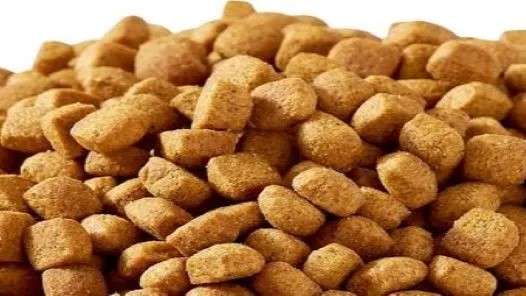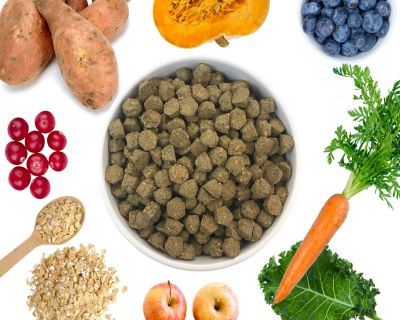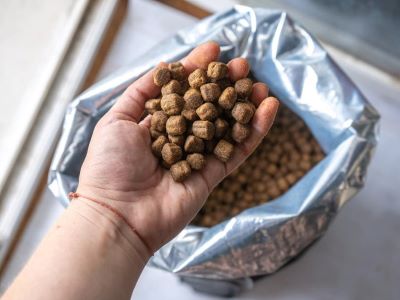As a paw parent, you always try to provide your Fido with ample amounts of nutrients and minerals to keep him happy and healthy. How about feeding kibbles to your dog? But, before that what is kibble dog food and why is it so popular among dog 🐶 owners?
Kibble is a type of dry dog food that consists of small, crunchy pellets that are usually made from a mixture of meat 🥩, grains 🌾, vegetables 🥕 and other ingredients. Moreover, kibble is one of the most common and convenient ways to feed your dog. Let us explore in detail about its ingredients and benefits.

What Is Kibble Dog Food?
Kibble is a term that refers to any dry dog food that is shaped into small pellets or biscuits 🍪. It is popular among dog owners for several reasons, such as:
- It has a long shelf life and does not require refrigeration or special packaging.
- It is easy to measure, store, and transport.
- It is relatively cheap and widely available in different brands and flavours.
- It can help clean your dog’s teeth and gums by scraping off plaque and tartar.
- It can be mixed with wet food 🥘, water 💧 or broth to add variety and moisture to your dog’s diet.
What Are the Main Ingredients of Kibble Dog Food?
Before feeding your dog kibbles, you should understand what’s inside the pack. It is necessary to feed quality food to your dog to maintain his health and promote physical 💪 as well as mental 🧠 growth.

As per the American Kennel Club, “A good dog 🐶 food will contain meat, vegetables, grains, and fruits. The best dog foods contain high-quality versions of these ingredients that are appropriate for your dog’s digestive system.“
The main ingredients of kibble dog food are:
- Meat: This includes beef, chicken, lamb or other animal sources. Meat provides protein, fat, amino acids, vitamins and minerals for your dog’s health.
- Vegetables: Carrots, peas, potatoes, sweet potatoes or other plant sources can be included in kibbles. They provide fibre, vitamins, minerals and antioxidants for your dog’s immune system.
- Grains: This can include corn, wheat, rice, barley or oats. Grains provide carbohydrates, fibre, vitamins and minerals for your dog’s energy and digestion.
- Other ingredients: Last but not least kibbles also comprise eggs, dairy products, fruits, nuts, seeds, herbs or spices. They are mainly added to improve the taste, smell and appearance of kibbles.
Benefits of Eating Kibbles
With so many ingredients in the kibble, are there any benefits for your dog’s health? Of course, there are! Kibble food is a healthy option to consider for your dog. Not only does it provide balanced nutrition but is also affordable and convenient.
- Balanced nutrition:
Kibble is formulated to meet the nutritional requirements of dogs 🐶 according to their age, size, breed, activity level or health condition. It contains a balanced ratio of nutrients, vitamins and minerals that your dog needs for optimal health. It also complies with the standards and regulations of the AAFCO (An organization that sets the minimum nutritional levels for pet food in the United States).
- Convenience:
Kibble is easy to feed, store and transport. You can simply measure the amount of kibble that your dog needs according to the feeding guidelines and ready to serve! No need to refrigerate or reheat kibble before feeding. You can also store kibble for a long time without worrying about spoilage.[1]
- Dental Health:
Kibble can help clean your dog’s teeth 🦷 and gums by scraping off plaque and tartar. This can prevent dental problems such as bad breath, cavities or periodontitis. It can also strengthen your dog’s jaw muscles and prevent tooth loss.
According to Ryan Llera and Cheryl Yuill at VCA Hospitals, “Some dry kibble rations have been specially formulated as dental diets and can help to mechanically remove plaque.“
- Affordability:
Kibble is relatively cheap compared to other types of dog food such as wet or raw food. You can buy kibble in bulk and save money in the long run. Choose from a wide range of brands and prices that suit your budget.
How Much Kibbles Should You Feed Your Dog?
The amount of kibble you should feed your dog 🐶 depends on several factors such as your dog’s weight, age, activity level and health condition. Different brands of kibble may have different feeding recommendations on their labels, however, these are only general suggestions and you may need to adjust the amount of kibble based on your dog’s individual needs and preferences.[2]

Refer to the table for the amount of kibble to feed the dog:
| Adult Dog Size (lbs) | Dry Food Feeding Amount (Cups) |
|---|---|
| 3 to 12 | 1/3 to 1 |
| 13 to 20 | 1 to 1-1/3 |
| 21 to 35 | 1-1/3 to 2 |
| 26 to 50 | 2 to 2-2/3 |
| 51 to 75 | 2-2/3 to 3-1/3 |
| 76 to 100 | 3-1/3 to 4-1/4 |
| 100+ | 4-1/4 plus 1/4 cup for each 10 lbs of body weight over 100 lbs |
For dogs with sensitivities or health issues like diarrhoea, alternatives like wet food or homemade food may be easier to digest. Be sure to consult your vet on what food to feed a dog with diarrhoea.
Alternatives to Kibble Dog Food
If you want to feed your dog something other than kibble, you may be wondering – what can I feed my dog instead of dog food
Some alternatives to kibble dog food:
- Wet food: It contains a high amount of moisture and meat. Wet food may have more protein and fat as compared to kibbles. It also keeps the dog hydrated 💧.
- Raw food: It can benefit the dog 🐶 as it is natural and unprocessed. However, it can be expensive and some raw food may pose health hazards to the dog.
- Homemade food: It can be cooked at home using human-grade ingredients. It can be a good option for your Fido, but homemade food can cause nutritional deficiencies if not formulated correctly.
Homemade food allows you to control the ingredients, including adding dog gravy granules for more flavor and moisture. Be sure to consult your vet on balanced homemade recipes
FAQs
What is the difference between kibble and regular dog food?
In terms of canine nutrition, raw dog food contains natural vitamins, minerals and amino acids. Kibble is processed at high temperatures, which results in the loss of these vital nutrients. The only option is to then add them back in, in synthetic form.
Is kibble good for dogs?
Domesticated dogs are largely carnivores that eat some omnivorous foods. It is important to ensure your dog’s food is both complete and balanced for its stage of life, and if it has any medical issues. It is entirely acceptable to feed your dog a pure kibble diet.
Is Kibble cheaper than raw?
While raw meals are typically more expensive than kibble, there are ways to incorporate raw feeding into your pet’s diet while keeping costs low. Consider using raw pet food as a topper or base for dry dog food to stretch it further.
Why don’t dogs eat kibble?
Many dogs won’t eat if they’re not feeling well, especially if they’re suffering from intestinal or dental issues, so you should visit your veterinarian to make sure nothing’s wrong. But if your dog eats other kinds of food (like wet food or snacks) and refuses to touch his dry food, it may mean he’s a picky eater.
Final Thought
So, what is dog kibble food? Kibble is a popular type of dry dog food that has many benefits and drawbacks. Kibble can provide balanced nutrition 🥕, convenience and affordability for your dog. However, kibble can also contain harmful ingredients or contaminants that can affect your dog’s health.
Therefore, you should choose the best kibble for your dog’s needs and preferences by considering factors such as the quality of the ingredients and the nutritional value of the kibbles. Also, consult your veterinarian before switching or supplementing your dog’s diet with kibble. Happy feeding!🐶
References:
- Henton, L. (2023, June 29). Offering Spoiled Food Is No Way To Spoil Your Pet – Texas A&M Today. Texas A&M Today.
- Centre for Veterinary Medicine. (2020). “Complete and balanced” pet food. U.S. Food And Drug Administration.



